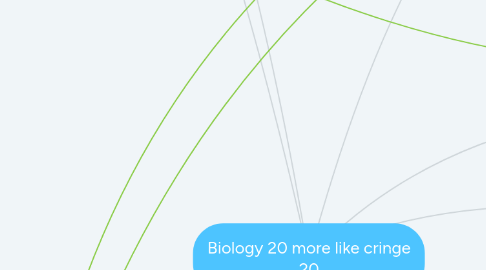
1. Human Systems
1.1. Macromolecules
1.1.1. Proteins
1.1.1.1. Enzymatic Catalyst
1.1.1.2. Sensory Perception and Hormonal Regulation
1.1.1.3. Denaturation and Deamination
1.1.2. Carbohydrates
1.1.2.1. Polymers / Monomers
1.1.2.2. Dehydration Synthesis / Hydrolysis
1.1.2.3. Monosaccarides
1.1.2.4. Disaccarides
1.1.2.5. Polysaccarides
1.1.3. Lipids
1.1.3.1. Triglycerides
1.1.3.2. Phospolipids
1.1.3.3. Steroids
1.1.4. Nucleic Acids
1.1.5. DNA / RNA
1.2. Enzymes
1.2.1. Inhibitors
1.2.1.1. Non Competitive
1.2.1.2. Competitive
2. Photosynthesis and Cellular Respiration
2.1. Cell Membrane
2.1.1. Passive Transport - Semi Permeable, Diffusion and Osmosis
2.2. Facilitated Diffusion, Carrier Proteins and Channel proteins
2.3. Endocytosis and Exocytosis
2.4. ATP
2.5. Metabolism
2.5.1. Anabolic and Catabolic Pathways
2.6. Active Transport - Uses Adenosine Triphosphate (ATP)
3. Digestive System
3.1. Ingestion
3.2. Digestion
3.3. Absorption
3.4. Egestion
3.5. Oral cavity, Esophagus, Stomach,Small and large intestine,Anus
3.6. Cardiac and Pyloric Sphincter
3.7. Ulcers
3.8. Accessory Organs
3.8.1. Bile,Gall Bladder,Pancreas,Duodenum,Liver,Acid Chyme,Intestinal Juice,
4. Respiratory System
4.1. Oxygen Brought in. Carbon Dioxide Removed
4.2. Breathing,External and Internal Respiration, Cellular Respiration
4.3. Upper Respiratory Tract
4.3.1. Nasal Cavity, Pharynx, Glottis, Epiglottis, Larynx, Trachea
4.4. Lower Respiratory Tract
4.4.1. Pleural Membrane,Bronchi,Bronchioles,Alveolus,
4.5. Intercostal/ Rib Muscles, Diaphragm,
4.6. External Respiration
4.7. Hemoglobin
4.8. Internal Respiration
4.9. Regulation of Breathing
5. Circulatory System
5.1. Transport gases, Nutrients, Waste and Hormones
5.2. Regulate internal temperature
5.3. Protects against invading pathogens
5.4. Blood Vessels
5.4.1. Arteries,Veins and Capillaries
5.5. Vasodilation and Vasoconstriction
5.6. Cardiac Muscles
5.7. Atria,Ventricles, Septums, Heart Valves, Atrioventricular Valves - Triscupid and biscupid valves, Semi Luner Valves - Pulmonary and Aortic Valves.
5.8. Blood Flow, Superior and Inferior Vena Cava, Right Atrium, Right Ventricle, Left and Right Pulmonary Arteries, Lungs, Heart, Left Atrium, Left Ventricle, Aorta.
5.9. Coronary Pathway and Arteries
6. Blood Cells
6.1. Plasma, Buffy Coat leukocytes and platelets and erythrocytes
6.2. Red blood cells
6.2.1. Hemoglobin
6.3. White Blood Cells
6.3.1. Granulocytes, monocytes, lymphocytes
7. Immune System
7.1. Antigen and Antibody
7.2. Three Lines of defence
7.3. Physical Defences
7.4. Non-Specific Defences
7.5. Specific Defences
7.5.1. T-Cells and B-Cells
8. Excretory System
8.1. Regulate Volume and Composition of Body Fluids
8.2. Maintaining electrolytes, PH and water balance
8.3. Removes carbon dioxide (from cellular respiration)
8.4. Liver removes lactic acids (Anaerobic Cell Resp)
8.5. Kidney's remove ammonia and uric acid
8.6. Ureters,Urinary Bladder,Urinary Sphinter, Urethra
8.7. Kidney
8.7.1. Renal Cortex, Renal medulla, renal pelvis, Renal Artery, Renal Vein, Nephrons,Nephron Filter, Nephron Tubule, Nephron Duct
8.8. Urine Formation - Proximal Tubule, Descending Loop of Henle, Ascending Loop of Henle, Distal Tubule, Collecting Duct
8.9. Osmoreceptors
9. Muscular System
9.1. Muscle Functions
9.1.1. Movement
9.1.2. Locomotion
9.1.3. Food Digestion
9.1.4. Urinating
9.1.5. Posture Maintainace
9.1.6. Joint Stability and Heat Generation
9.2. Cardiac Muscle Tissue
9.2.1. Pacemaker
9.2.2. Striated
9.2.3. Found in heart
9.2.4. Involuntary
9.3. Skeletal Muscle Tissue
9.3.1. Long Thin Fibers
9.3.2. Striated
9.3.3. Voluntary
9.3.4. Contract Rapidly
9.3.5. Tire Easily
9.4. Smooth Muscle Tissue
9.4.1. Lacks Striations
9.4.2. Involuntary
9.4.3. Contractions are slow and sustained
10. Photosynthesis
10.1. "Light" "Put Together"
10.2. 6CO2+6H20+Solar Energy -> C6H12O6+6O2 (Relates to Ecosystems and Cycles of matter)
10.3. Carbon Dioxide and water in +Sunlight forms carbohydrates and releases oxygen
10.4. Light Dependent and Light Independent Reactions "Calvin Cycle"
10.5. NADPH
10.6. Redox Reactions - Oxidation Reduction
10.7. H20 and O2
10.8. Electron Transport Chain
10.9. Calvin Cycle
10.9.1. Carbon Dioxide Fixation
10.9.2. Rubisco
10.9.3. PGA
10.9.4. PGAL
10.9.5. RuBP
10.9.6. Glucose (C6H12O6)
10.10. ADP and NADH
10.11. Chlorophyll A and B - Found in Chloroplast
10.11.1. Thylakoid Membrane, Outer/inner membrane, Granum,Lamella,Lumen
11. Cellular Respiration
11.1. Breaks down carbohydrates and Energy Rich products to generate ATP
11.2. C6H12O6 + 6O2 -> 6CO2 + 6H20 + Energy
11.3. Mitochondria
11.3.1. Inner and Outer Membrane, Cristae and Matrix
11.4. Anaerobic and Aerobic Respiration and Fermentation
11.5. Glycolosis
11.6. Pyruvate Oxidation
11.7. Krebs Cycle
11.7.1. Acetyl CoA, NAD+ -> NADH, ADP -> ATP, FAD -> FADH2, 2x
11.8. Ethanol and Lactate Fermantation
12. Population and Individual
13. Ecology And Population Change
13.1. Natural Selection
13.2. Genotype vs Phenotype
13.3. Adaptation and Variation
13.4. Speciation/Species
13.5. Heritable Mutations
14. Energy and Matter Exchange
14.1. Ecology and Ecosystems
14.1.1. Biosphere
14.2. Autotroph/Producers (Photosynthesis and Chemeosythesis)
14.3. Consumer/Heterotroph (Cellular Respiration)
14.4. Primary Consumers - Herbivores
14.5. Secondary Consumers - Carnivores or Omnivores
14.6. Tertiary Consumers - Carnivores
14.7. Decomposers or detrivores
15. Ecology
15.1. Anton van Leeuwenhoek - Kingdoms: Animals, Plants and Protists
15.2. Aristotle - Kingdoms:Plants and Animals
15.3. Taxonomy
15.4. Herbert Copeland
15.5. Edouard Chatton - Divided Life:Eukarya and Prokarya
15.6. Carl Woese - Divided Life: Eukarya,Bacteria and Archaea
15.7. Binomial Nomenclature
15.8. Environment - Biotic and Abiotic
15.9. Community
15.10. Biomes
15.11. Carolus Linnaeus - Phylum,Class,Order,Family,Genus and Species
16. Ecology PT2
16.1. Habitat
16.2. Ecological Niche
16.3. Profundal Zone
16.4. Benthic Zone
16.5. Limnetic Zone
16.6. Littoral Zone
16.7. Limiting Factors
16.8. Intraspecies Competition
16.9. Interspecies Competition
17. Population Change PT2
17.1. Sexual Reproduction
17.2. Creationism vs Transmutationism
17.3. Georges-Lewis Leclarc, Comte de Buffon - Different Regions had different plants and animals
17.4. George Cuvier - Paleontology
17.5. Jean-Baptiste Lamarck
17.6. Sir Charles Lyell - Father of modern geology
17.7. Charles Darwin - Theory of natural selection
17.8. Alfred Wallace
18. Natural Selection
18.1. Overproduction - more offspring than given resources
18.2. Struggles for existence/competition - Excess number of offspring, Competition leads to a limited amount of resources
18.3. Natural Selection - Selective Pressure and Selective advantage
18.4. Variation - Differences exist between individuals within the population
18.5. Survival of the fittest/natural selection - Individuals with different traits allow them to be better competitors
18.6. Origin of new species / Speciation
19. Evidence of Evolution
19.1. Fossil Record
19.2. Embryology
19.3. Comparative anatomy
19.4. Vestigial Organs
19.5. Biogeography
19.5.1. Molecular Genetics
20. Cycling of Energy
20.1. Trophic Levels
20.2. Law of thermodynamics
20.3. Rule of Ten
20.4. Food Chain / Food web
20.5. Trophic Cascade
20.6. Ecological Pyramid
20.6.1. Pyramid of numbers
20.6.2. Pyramid of Biomass
20.6.3. Pyramid of energy
